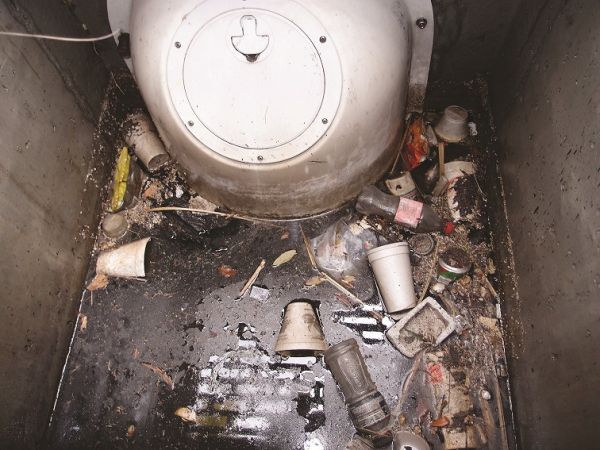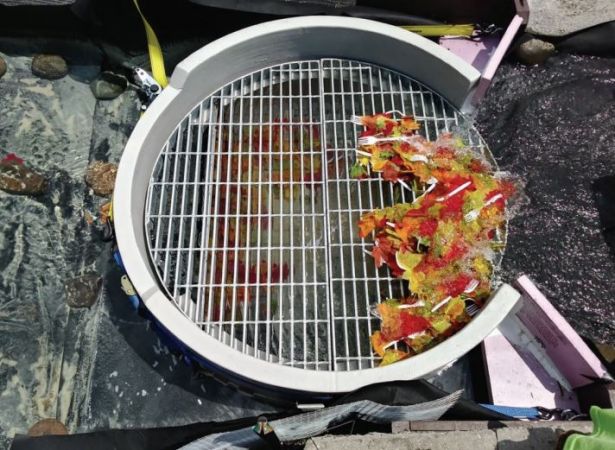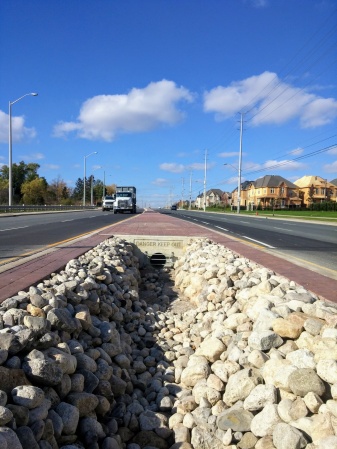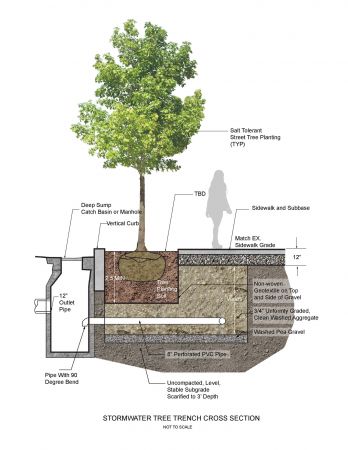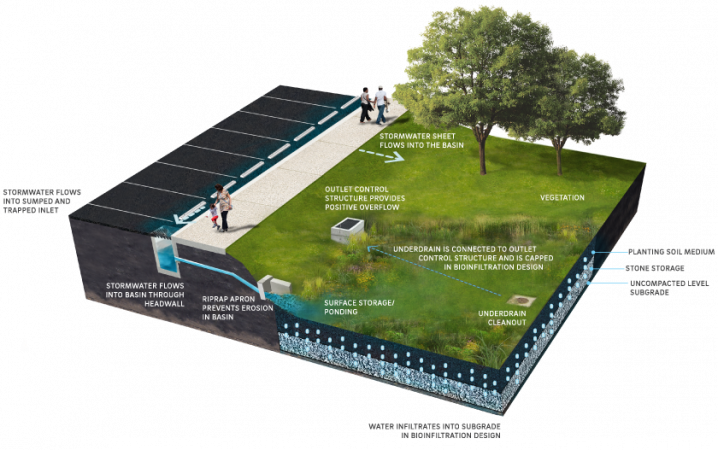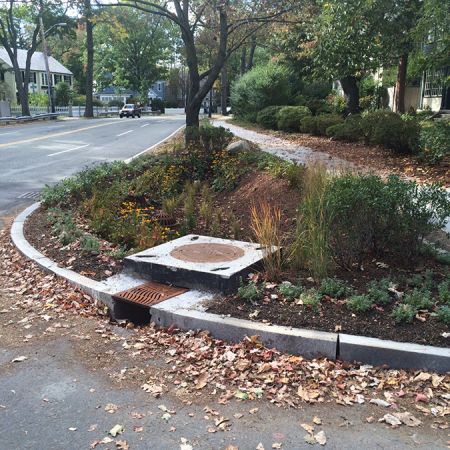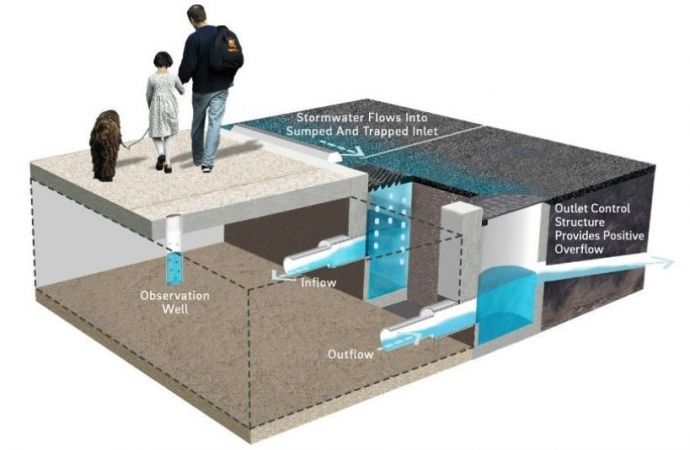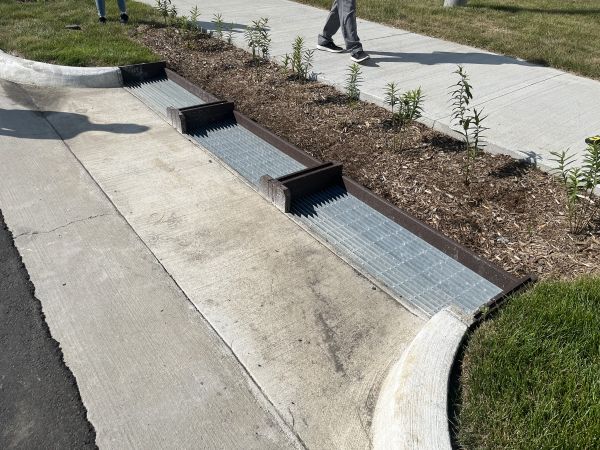Difference between revisions of "Pretreatment"
| (49 intermediate revisions by 3 users not shown) | |||
| Line 1: | Line 1: | ||
| − | [[File: | + | [[File:Sediment pad.JPG|thumb|650px|This non-proprietary pre-treatment device, known as a "Sediment Pad" that is used by the City of Toronto to capture coarse sediment, trash and debris in runoff before water drains into bioretention or other similar green stormwater infrastructure practices. Centralizing sediment and debris capture in a small area near the inlet to the [[bioretention]] feature helps simplify maintenance (City of Toronto, 2021<ref>City of Toronto. 2021. Curb Cut Inlet with Sediment Pad – Layout and Section. ENGINEERING & CONSTRUCTION SERVICES STANDARD DRAWING. Accessed. https://www.toronto.ca/wp-content/uploads/2021/08/9598-ecs-specs-gi-dwgs-T-850.102-Rev0-Sep2021.pdf</ref>.]] |
Pretreatment devices may be constructed in close association association with one or more [[inlets]]. Different configurations of each exist to accommodate any design. | Pretreatment devices may be constructed in close association association with one or more [[inlets]]. Different configurations of each exist to accommodate any design. | ||
{{TOClimit|2}} | {{TOClimit|2}} | ||
| + | [[File:Sediment pad Toronto.JPG|thumb|450px|Another example of the City of Toronto's non-proprietary pre-treatment device, known as a "Sediment Pad" shown being used at the curb [[inlet]] of a [[bioretention]] cell on Danforth Av. to capture coarse sediment, trash and debris in influent entering the BMP.]] | ||
==Overland sheet flow== | ==Overland sheet flow== | ||
The following pretreatement features are recommended where surface sheet flow is being directed to a BMP (e.g. a [[Bioretention cells|bioretention cell]]) receiving flow from the edge of an impermeable surface such as an asphalt parking lot or a paved plaza: | The following pretreatement features are recommended where surface sheet flow is being directed to a BMP (e.g. a [[Bioretention cells|bioretention cell]]) receiving flow from the edge of an impermeable surface such as an asphalt parking lot or a paved plaza: | ||
| Line 14: | Line 15: | ||
* Catch basin or other pre-fabricated inlet structure sump; | * Catch basin or other pre-fabricated inlet structure sump; | ||
* [[Level spreader]]; | * [[Level spreader]]; | ||
| − | *[[Pretreatment features| Forebays]] (well suited for bioretention cells); | + | *[[Pretreatment features| Forebays]] (well suited for bioretention cells). See [[Pretreatment features]] for guidance on sizing.; |
* [[Stone]] and [[geotextile]] filter: A shallow excavation on the filter media bed surface at the inlet, lined with geotextile and rip rap or decorative stone cover; and, | * [[Stone]] and [[geotextile]] filter: A shallow excavation on the filter media bed surface at the inlet, lined with geotextile and rip rap or decorative stone cover; and, | ||
| − | *[[Sand filters]] (well suited for underground [[infiltration]]). | + | *[[Sand filters]] (well suited for underground [[infiltration]]); |
| + | *Concrete sump pretreatment device. [https://rainguardian.biz/ Rain Guardian] is one example of a proprietary sump device. | ||
==Concentrated underground flow== | ==Concentrated underground flow== | ||
| − | This type of | + | This type of pretreatment is dominated by proprietary systems, some of which have undergone verification under the [http://etvcanada.ca/ Environmental Technology Verification (ETV) Canada] program. Pretreatment devices suited to concentrated underground flow, or pipe flow include the following: |
| + | * Oil and grit (hydrodynamic) separators | ||
| + | * Manhole baffles | ||
| + | * Isolated chamber row filters | ||
| + | * Membrane filters | ||
| + | * Media filters | ||
| + | Membrane and media filters are more commonly used as "stand alone" water quality treatment practices when space for surface practices is not available, but may also be used downstream of LID facilities or treatment trains to enhance removal of sediment and other targeted pollutants (e.g., nutrients, metals) where warranted by receiving water sensitivity. | ||
| + | <br> | ||
{|class="wikitable" | {|class="wikitable" | ||
| Line 26: | Line 35: | ||
!style="width: 10%;"|Type | !style="width: 10%;"|Type | ||
!style="width: 40%;"|Description | !style="width: 40%;"|Description | ||
| − | !style="width: 25%;"|ETV products | + | !style="width: 25%;"|ETV Canada verified products |
!style="width: 25%;"|Other products (not verified) | !style="width: 25%;"|Other products (not verified) | ||
| + | |- | ||
| + | !Overland flow sumps | ||
| + | |Collects and settles debris as overland flow passes through sump to treatment practice.|| | ||
| + | | | ||
| + | *Catch basin or other non-proprietary pre-fabricated inlet structure sump. Small forebays may also be used for treatments systems receiving concentrated overland flow’ | ||
| + | *[https://www.rainguardian.biz/ Rain Guardian] | ||
|- | |- | ||
!Catch basin inserts | !Catch basin inserts | ||
|Great for improving water quality in retrofit situations | |Great for improving water quality in retrofit situations | ||
| | | | ||
| − | *[ | + | *[https://etvcanada.ca/wp-content/uploads/2019/10/ISO-14034-ETV-Verification-Renewal-CB-Shield_2019-2022.pdf CB Shield] |
| + | *[https://etvcanada.ca/wp-content/uploads/2022/03/ISO-14034-ETV-VS-ENVIROBASIN_2021-2024.pdf Littatrap (Now, EnviroBasin™)] | ||
| | | | ||
| − | |||
*[http://www.bmpinc.com/ Snout] | *[http://www.bmpinc.com/ Snout] | ||
| + | |- | ||
| + | !Oil and grit (hydrodynamic) separators | ||
| + | |The shape causes rapidly flowing water to form a vortex which forces the larger, heavier particles are outwards and downwards into a lower chamber. Floating debris, oils and grease are trapped behind a baffle or in small tank area, towards the top of the main vortex chamber | ||
| + | | | ||
| + | *[https://etvcanada.ca/wp-content/uploads/2023/03/ISO-14034-ETV-Verification-Contech-CDS_2023-2026.pdf CDS] | ||
| + | *[https://www.verifiglobal.com/media/tsmpnsdh/vg-2019-09-01-hi-downstream-defender-verification-statement-re-issue-v2-for-posting-2022-09-15.pdf?la=da Downstream Defender] | ||
| + | *[https://www.verifiglobal.com/media/xr3he5i2/vg-2018-10-01-hi-fdhc-final-for-posting-2018-10-15-rev-2019-02-01.pdf First Defense] | ||
| + | *[https://etvcanada.ca/wp-content/uploads/2021/05/ISO14034-VS_Hydroworks_HS_2021-2024.pdf Hydrostorm] | ||
| + | *[https://etvcanada.ca/wp-content/uploads/2022/02/ISO14034-Verification-Statement_BioClean-SciCLONE_2022-2025.pdf SCICLONE HDS] | ||
| + | *[https://etvcanada.ca/wp-content/uploads/2022/10/ISO-14034-ETV-Verification-Statement-NEXT-SDD3_2022-2025-EN.pdf SDD] | ||
| + | *[https://etvcanada.ca/wp-content/uploads/2020/11/ISO-14034-Verification-Statement-_Stormceptor_EF-EFO_2020-2023.pdf Stormceptor EF] | ||
| + | *[https://www.verifiglobal.com/media/3drliqul/verifiglobal-verification-statement-for-stormtrap-stormsettler-ogs-signed-2023-09-13.pdf StormTrap Storm Settler] | ||
| + | | | ||
| + | *[http://upstreamtechnologies.us/products/safl.shtml SAFL Baffle] | ||
|- | |- | ||
!Manhole baffles | !Manhole baffles | ||
| Line 42: | Line 71: | ||
*[http://upstreamtechnologies.us/products/safl.shtml SAFL Baffle] | *[http://upstreamtechnologies.us/products/safl.shtml SAFL Baffle] | ||
|- | |- | ||
| − | + | !Isolated chamber row | |
| − | |||
| − | |||
| − | |||
| − | |||
| − | |||
| − | |||
| − | |||
| − | |||
| − | |||
| − | |||
| − | !Isolated chamber row | ||
|Separate rows at inlets, not connected by pipes to the other chambers, that isolate the bulk of sediment and associated pollutants and designed for ease of access by jet flushing cleaning equipment. | |Separate rows at inlets, not connected by pipes to the other chambers, that isolate the bulk of sediment and associated pollutants and designed for ease of access by jet flushing cleaning equipment. | ||
| | | | ||
| − | *[https:// | + | *[https://etvcanada.ca/wp-content/uploads/2022/03/ISO-ETV-VS_Cultec-Separator-Row_2021-2024_v2.pdf Cultec Separator Row] |
| + | *[https://www.verifiglobal.com/media/knubjbej/verifiglobal-verification-statement-for-stormtech-isolator-row-plus-final-2020-10-27-for-posting.pdf StormTech Isolator Row Plus®] | ||
| | | | ||
| + | *[https://www.conteches.com/Stormwater-Management/Detention-and-Infiltration/ChamberMaxx-Plastic-Chambers ChamberMaxx®] | ||
|- | |- | ||
!Membrane filters | !Membrane filters | ||
|Uses advanced membrane technology adapted from water treatment plants. | |Uses advanced membrane technology adapted from water treatment plants. | ||
| | | | ||
| − | *[ | + | *[https://etvcanada.ca/wp-content/uploads/2023/08/ISO-ETV-Verification-Statement-Imbrium-Jellyfish_2023-2026.pdf Jellyfish Filter (TARP)] |
| − | *[https:// | + | *[https://etvcanada.ca/wp-content/uploads/2022/03/ISO14034-ETV-VS_Imbrium-Jellyfish-Filter_2022-2025.pdf Jellyfish Filter (TAPE)] |
| + | *[https://etvcanada.ca/wp-content/uploads/2022/09/ISO-14034-ETV-Verification-Statement-Kraken-TAPE_2022-2025.pdf Kraken Membrane Filtration (TAPE)] | ||
| | | | ||
|- | |- | ||
| Line 69: | Line 90: | ||
|A variety of proprietary designs and media mixes are available. | |A variety of proprietary designs and media mixes are available. | ||
| | | | ||
| − | *[ | + | *[https://etvcanada.ca/wp-content/uploads/2021/12/ISO14034-ETV-VS_Imbrium-Filterra_2021-2024.pdf Filterra] |
| − | + | *[https://www.verifiglobal.com/media/zoinc1we/verifiglobal-verification-statement-for-baysaver-bayfilter-final-for-posting-2018-10-29.pdf BaySaver BayFilter] | |
| − | *[https:// | + | *[https://etvcanada.ca/wp-content/uploads/2023/06/ISO-14034-ETV-Contech-StormFilter_TAPE_2023-06-30-Final.pdf The Stormwater Management StormFilter (TAPE)] |
| − | *[https://www. | + | *[https://www.verifiglobal.com/media/fl2dqtrj/vg20190601-hi-uff-verification-statement-final-amended-2-20200513-for-posting.pdf Up-Flo Filter] |
| | | | ||
| − | + | *[https://www.imbriumsystems.com/stormwater-treatment-solutions/sorbtive-media Sorbtive Media] | |
| − | + | *[[Bioretention]] [[Filter Media]] | |
| − | + | *[https://www.stormwatercenter.net/Assorted%20Fact%20Sheets/Tool6_Stormwater_Practices/Filtering%20Practice/Sand%20and%20Organic%20Filter%20Strip.htm Sand Filters<ref>Stormwater Manager's Resource Center. n.d. Stormwater Management Fact Sheet: Sand and Organic Filter. Accessed: https://www.stormwatercenter.net/Assorted%20Fact%20Sheets/Tool6_Stormwater_Practices/Filtering%20Practice/Sand%20and%20Organic%20Filter%20Strip.htm</ref>] | |
| − | + | *[https://www.water-pollutionsolutions.com/gutter-guards.html Gutter Guards/Filters] | |
| − | *[ | + | *[https://www.freshwatersystems.com/blogs/blog/types-of-downspout-filters Downspout Filters] |
| − | * | + | *[[Media filters]] |
| − | * | + | *[https://apps.ecology.wa.gov/publications/documents/2110023.pdf High Performance Soil Media Mixes<ref>Howie, D., and Lubliner, B. 2021. Guidance on using new high performance bioretention soil mixes. "Water Quality Program", |
| + | Washington State Department of Ecology. Olympia, Washington. May 2021 - Publication 21-10-023.</ref>] | ||
|- | |- | ||
|} | |} | ||
| + | This table and page are particularly heavy on proprietary systems and information. Please inform us of any omissions or broken links using the box below: | ||
| + | |||
| + | <br> | ||
| + | </br> | ||
| + | |||
| + | ==Gallery== | ||
| + | {{:Inlet sumps: Gallery}} | ||
| − | + | ==References== | |
[[category: Pretreatment]] | [[category: Pretreatment]] | ||
Latest revision as of 15:48, 12 February 2024
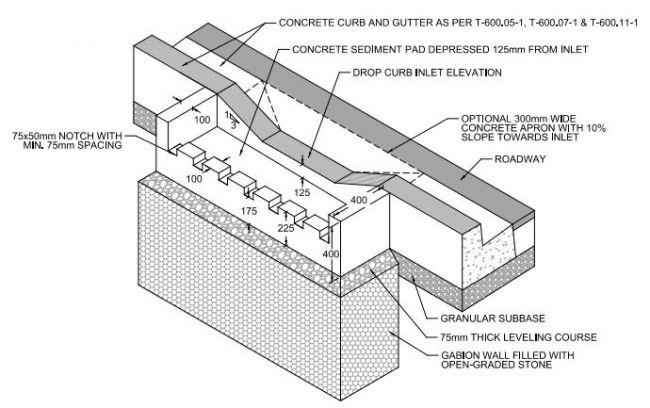
Pretreatment devices may be constructed in close association association with one or more inlets. Different configurations of each exist to accommodate any design.
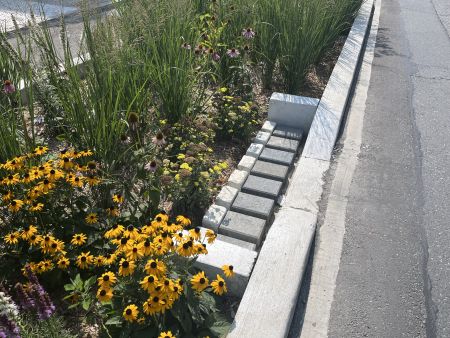
Overland sheet flow[edit]
The following pretreatement features are recommended where surface sheet flow is being directed to a BMP (e.g. a bioretention cell) receiving flow from the edge of an impermeable surface such as an asphalt parking lot or a paved plaza:
A gravel diaphragm typically requires less setback between the catchment and the BMP. Where space permits, these designs can be used in combination to even greater effect!
Concentrated overland flow[edit]
Where a curb cut, a disconnected roof downspout pipe, swale, trench drain, side inlet catch basin or other pre-fabricated inlet structure collects and conveys runoff as concentrated overland flow, which increases the flow rate, one or more of the following pretreatment features should be considered:
- Catch basin or other pre-fabricated inlet structure sump;
- Level spreader;
- Forebays (well suited for bioretention cells). See Pretreatment features for guidance on sizing.;
- Stone and geotextile filter: A shallow excavation on the filter media bed surface at the inlet, lined with geotextile and rip rap or decorative stone cover; and,
- Sand filters (well suited for underground infiltration);
- Concrete sump pretreatment device. Rain Guardian is one example of a proprietary sump device.
Concentrated underground flow[edit]
This type of pretreatment is dominated by proprietary systems, some of which have undergone verification under the Environmental Technology Verification (ETV) Canada program. Pretreatment devices suited to concentrated underground flow, or pipe flow include the following:
- Oil and grit (hydrodynamic) separators
- Manhole baffles
- Isolated chamber row filters
- Membrane filters
- Media filters
Membrane and media filters are more commonly used as "stand alone" water quality treatment practices when space for surface practices is not available, but may also be used downstream of LID facilities or treatment trains to enhance removal of sediment and other targeted pollutants (e.g., nutrients, metals) where warranted by receiving water sensitivity.
| Type | Description | ETV Canada verified products | Other products (not verified) |
|---|---|---|---|
| Overland flow sumps | Collects and settles debris as overland flow passes through sump to treatment practice. |
| |
| Catch basin inserts | Great for improving water quality in retrofit situations | ||
| Oil and grit (hydrodynamic) separators | The shape causes rapidly flowing water to form a vortex which forces the larger, heavier particles are outwards and downwards into a lower chamber. Floating debris, oils and grease are trapped behind a baffle or in small tank area, towards the top of the main vortex chamber | ||
| Manhole baffles | Baffles slow flow, encouraging larger, heavier particles to drop out of the water column. A skimmer may also trap floating debris, oils and grease. | ||
| Isolated chamber row | Separate rows at inlets, not connected by pipes to the other chambers, that isolate the bulk of sediment and associated pollutants and designed for ease of access by jet flushing cleaning equipment. | ||
| Membrane filters | Uses advanced membrane technology adapted from water treatment plants. | ||
| Media filters | A variety of proprietary designs and media mixes are available. |
This table and page are particularly heavy on proprietary systems and information. Please inform us of any omissions or broken links using the box below:
Gallery[edit]
This pretreatment device, known as a baffle helps to remove trash, oil, TSS, larger sediments (silts, sands, etc.) and other floatables in roadway catch basins. This picture was taken of a SNOUT BAFL in Myrtle Beach, S.C. (Mullen, 2022)[4]
Example of an overland flow sump, capturing stormwater runoff from the adjacent roadway. This example showcases a Rain Guardian(TM) Turret structure with a metal grate overtop to capture larger floatables, trash and detritus from entering a stormwater facility or in this case a bioretention LID feature[5].
A stormwater tree trench, including a sump inlet design used as part of pretreatment. The feature is located in the City of Cambridge, Massachusetts, US. The design was developed and lead by HDR Inc., and Halvorson, Tighe & Bond Studio (Halvorson, Tighe & Bond Studio, n.d.)[6]
Example of a sump inlet being used in conjunction with a large bioretention basin feature, located in park space receiving stormwater off of the adjacent roadway (Source: Philadelphia Water Department, n.d.)[7]
An inlet sump leading into a bioretention bump out for traffic calming. Inlet sumps help both settle and separate sediment from stormwater road runoff before depositing excess sediment and silt into an infiltration BMP. These sumps allow stormwater to flow into the feature through an underdrain pipe (Source: NACTO, 2017)[8]
Example of a sump inlet allowing sediment to settle out of influent stormwater before entering a large infiltration chamber housed under the parking lot (Source: Philadelphia Water Department. 2020)[9]
Example of a proprietary inlet device known as a Rain Guardian Bunker, that was installed at the Morningside Extension Project in Scarborough, ON.
References[edit]
- ↑ City of Toronto. 2021. Curb Cut Inlet with Sediment Pad – Layout and Section. ENGINEERING & CONSTRUCTION SERVICES STANDARD DRAWING. Accessed. https://www.toronto.ca/wp-content/uploads/2021/08/9598-ecs-specs-gi-dwgs-T-850.102-Rev0-Sep2021.pdf
- ↑ Stormwater Manager's Resource Center. n.d. Stormwater Management Fact Sheet: Sand and Organic Filter. Accessed: https://www.stormwatercenter.net/Assorted%20Fact%20Sheets/Tool6_Stormwater_Practices/Filtering%20Practice/Sand%20and%20Organic%20Filter%20Strip.htm
- ↑ Howie, D., and Lubliner, B. 2021. Guidance on using new high performance bioretention soil mixes. "Water Quality Program", Washington State Department of Ecology. Olympia, Washington. May 2021 - Publication 21-10-023.
- ↑ Mullen, T.J. Prioritizing trash capture and clean oceans: Stormwater hoods and traps lead the way in effectiveness. The Municipal magazine. June 1, 2022. Accessed: https://www.themunicipal.com/2022/06/prioritizing-trash-capture-and-clean-oceans-stormwater-hoods-and-traps-lead-the-way-in-effectiveness/
- ↑ Erickson, A.J. and Hernick, M.A., 2019. Capture of Gross Solids and Sediment by Pretreatment Practices for Bioretention. Accessed: https://conservancy.umn.edu/handle/11299/201607
- ↑ Halvorson, Tighe & Bond Studio. n.d. Halvorson, Tighe & Bond Studio. Retrieved from: https://www.halvorsondesign.com/willard-street-drainage
- ↑ Philadelphia Water Department. n.d. Chapter 4 Stormwater Management Practice Guidance 4.1 Bioinfiltration/Bioretention. Retrieved from: https://water.phila.gov/development/stormwater-plan-review/manual/chapter-4/4-1-bioinfiltration-bioretention/
- ↑ National Association of City Transportation Officials (NACTO). 2017. Urban Street Stormwater Guide - Inlet Design. Retrieved from: https://nacto.org/publication/urban-street-stormwater-guide/stormwater-elements/bioretention-design-considerations/inlet-design/
- ↑ Philadelphia Water Department. 2020. Stormwater Management Guidance Manual: Version 3.2. Accessed from: https://www.pwdplanreview.org/upload/manual_pdfs/PWD-SMGM-v3.2-20201001.pdf
